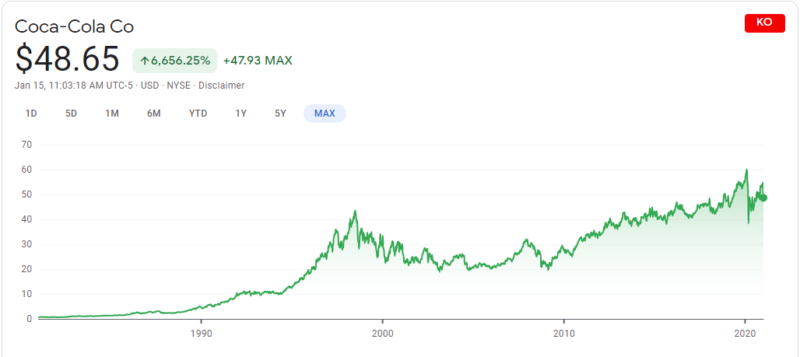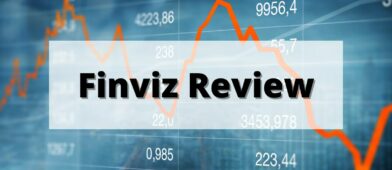I remember the first time I read Warren Buffett’s annual letter to Berkshire Hathaway shareholders. It was witty, it was entertaining, and it wasn’t anything like your standard annual report with glossy pages, full color photos, and mind-numbing marketing-speak.
That first time, the page that blew me away was his list of stock investments – specifically the dividend producing stocks.
Berkshire Hathaway, as of the 2017 letter, owns 400 million shares of stock at a cost of $1.299 billion. Each share pays out $1.48 a year. Berkshire Hathaway gets $592 million from Coca Cola every single year.
That’s an annual yield of 45.6%.
When we look at the 2019 letter, we see that he now gets $640 million in dividends each year (he hasn’t acquired any more shares of KO). His annual yield on this investment was 49.26% in 2019.
How is this possible!? What is this sorcery!?
Time is an investor’s best friend.
Buffett acquired shares of Coca-Cola in 1988. Back then he wrote “We expect to hold these securities for a long time. In fact, when we own portions of outstanding businesses with outstanding managements, our favorite holding period is forever. We are just the opposite of those who hurry to sell and book profits when companies perform well but who tenaciously hang on to businesses that disappoint. Peter Lynch aptly likens such behavior to cutting the flowers and watering the weeds.” (1998 letter)
The formula is simple. He bought the shares a long time ago, his cost basis was much lower than the market value, and KO kept increasing dividends. If you buy shares today of KO (at $48.67), you get 3.37% yield. Warren Buffett is getting close to 50%!
I wanted to replicate his success. I wanted to build a portfolio of blue-chip, dividend stocks that would produce passive income for us.
I’ll start with explaining where dividends fit in our existing portfolio, follow it up with a discussion of why we invest in individuals stocks and not dividend funds, a brief chat about the factors in our favor followed by the strategy I use to pick stocks. Let’s go!
My approach is ever-evolving – I will update it periodically as I update my approach. To succeed in anything, especially as an investor, you have to be constantly learning, refining, and improving your process. What you’re reading is what I do today but that might change in a few months or years, check back periodically for changes.
Table of Contents
Where Dividends Fit in Financial Picture
Before we get into how I built my dividend portfolio, it’s important to know how it all fits.
70% of our stock market investments are in various Vanguard funds. The balance is in individual dividend producing stocks. The Vanguard funds also produce dividends, since many stocks in the stock market produce dividends, but I don’t consider those funds part of the “dividend” section of our portfolio. The Vanguard 500 Index Fund Shares has a decent 1.74% yield, so it’s not inconsequential!
My goal with dividends was to create a stream of passive income that would act as insurance against the unpredictability of entrepreneurship. I can put them in a dividend tracker to keep them all straight.
In 2015, that stream amounted to $55,152.60, a 10.4% increase over 2014. (and what’s nice about this income is that it’s taxed at the 15% long term capital gain rate too!)
It would increase to $57,750 in 2016 and $64,981 in 2017.
Part of the increase is attributed to more investments, part of it was dividend growth. Dividend growth is especially attractive because I don’t have to commit any more money to get greater dividends… you can’t beat that!
Why Individual Stocks?
If low-cost index funds are the best, why not use a low-cost dividend fund from Vanguard? The Vanguard Dividend Appreciation Index Fund Investor Shares (VDAIX) has a 1.92% yield with an expense ratio of 0.17% (the Admiral version’s expense ratio is just 0.08%).
It holds many of the same companies that I would end up buying. At the end of Jan2016, 36.6% of the holdings were in Microsoft, J&J, Coca-Cola, P&G, Pepsi, Wal-Mart, IBM, CVS, Medtronic, and 3M… classic dividend producing blue chippers. As of this writing, of that list, I only own Microsoft, Medtronic, and Coca-Cola.
So why didn’t I go with a fund? I wanted to cherry-pick companies that had higher dividend growth rates and higher dividend yield. 2.25% on a dividend fund is meh, especially when the S&P 500 yields 1.74%, right? I wanted more.
I also wanted to have a little fun and scratch that stock picking itch in a way that was safe, smart, and fit our financial plan.
Don’t underestimate the value in responsibly scratching an itch. It’s better than I get to try my hand at picking dividend stocks than the alternatives. 🙂
A Few Factors in My Favor…
To put everything in better context, it’s important to know a few things I saw as my advantages:
- I just sold a company and had a sizable sum of investable assets – While this allowed me to grow my dividend portfolio faster, it didn’t give me any special access or advantage other than lower transaction fees on Vanguard.
- The great recession just brutalized stocks, I was getting them at a big discount – The bargains will be fewer and farther between now. General Electric was as low as ~$7 in March 2009! With so many bargains, I was able to make some mistakes and not get burned as badly by them.
- I have time on my side – I view our assets as a series of buckets. Near-term (needed within the next 5 years), middle term (5-10 years), and long-term (10+). All of this money was long-term money so I could put it in individual companies, with greater volatility, because I could wait out the volatility. Every stock I’ve owned for more than 3 years is positive (not positive in “real” terms, like vs. inflation or the S&P or any other benchmark, but they’re green).
I believe that if you need the money in the next five years, do not put it in the stock market. It’s just too volatile. If you don’t need it for 10+ years, it has to be in the stock market (or some other investment). It cannot be in cash, you give up too much growth.
I also believe that dividends are awesome. You’ve probably heard statistics that say dividends account for a big percentage of gains in the stock market (here’s an article by Bob Pisani about it). I see it as good insurance against income volatility, of which I experience a fair amount as an entrepreneur.
Check out the historical chart for KO, a Dividend King, on Google Finance:

In July 1998, KO hit $43.59 – a high that wouldn’t be revisited until October 2014. Ack!
That would stink if you needed your money because KO’s stock price languished for many many years. But… They kept on paying and increasing that dividend. KO’s stock price may have stunk but KO was doing its job and paying its dividend. That’s pretty awesome.
(Charts like that also make stock market bloodbaths more palatable — as long as the stocks keep doing their jobs!)
How I Built My Dividend Portfolio
My criteria for picking companies has slowly evolved over the years.
It’s not perfect, I don’t think any system ever is, but it has worked for me.
The first filter is that they must be a well-known household brand or be a Dividend King or Dividend Aristocrat. A Dividend King is a company that has increased their dividend for 50+ years, only 18 companies have done that.
A Dividend Aristocrat is a company that has increased its dividends for at least 25 years. (DRiP Investing Resource Center calls them Dividend Champions and organizes them in a very useful Excel spreadsheet) All Dividend Kings are Dividend Aristocrats.
As everyone knows, “past performance is not indicative of future results!” I fully believe that… but I don’t stop my analysis with those lists. They merely pare down the universe of stocks to a more reasonable subset. Also, 25 and 50 years is a long time. 🙂
The next filter is financial and the big number I want to look at has to do with dividend coverage. Dividend coverage is the company’s earnings per share divided by the dividend per share. I want earnings to be at least twice that of the dividend, or a dividend cover of 2 times. I also look at some of the other metrics many use to analyze a company (increases in earnings per share, equity per share growth percentage, etc.). The basic idea here is that I want to make sure they can continue paying the dividend (coverage) and that they can continue to grow the dividend (increasing EPS).
Now I’m confident that the company is financially stable, I check out is dividend growth. It needs to beat 3% each year, which is what I put in my head as average inflation. Inflation is such a fickle number but I’m confident that by having a growth rate greater than 3% means the dividend will grow faster than inflation.
Next, I start doing some searches about these companies on other financial websites I trust. Dividend Growth Investor is a blog I’ve been following for years, he does a good job of analyzing a lot of companies. His commenters are also excellent too and I’ve discovered folks like Passive Income Pursuit through him. I also like Crossing Wall Street, though it doesn’t have a dividend angle, it’s well informed and the Friday market reviews are a must-read.
I read other blogs, not for their analysis per se, but a lot of times they uncover news or tidbits I didn’t see. It’s also fun to read someone else’s approach and see what you can integrate into your own.
Lastly, know when to fold em. I sell when the conditions change. You always need to know when you plan to exit, or you run the risk of making decisions based on emotion. Just recently, ConocoPhillips announced they were slashing their dividend. I sold it because its purpose was to be a dividend stock (and at a certain yield)… and they cut their dividend from $2.96 a share to $1 a share. It’s still a dividend stock, just a lower yield one, but it stopped doing the job I needed.
If you’re thinking about investing in dividends and hoping to build a monthly cash flow from dividends, check dividend calendars to see when payouts happen so you can structure them effectively.
The Importance of Dividend Growth
The sneaky non-obvious part about dividend investing is that you can build a safe portfolio that produces ever-increasing cash flows. By selecting companies that grow their dividend faster than inflation, you are building a stream of income that grows upon itself.
You can also achieve this by automatic reinvestment of dividends because this will grow your stake in the company. This is useful if you’re don’t actually need the income. I don’t reinvest dividends because keeping track of those separate purchases can be a bit of a pain. I’d rather just buy more when favorable conditions present themselves.
Looking only at individual dividend stocks, my 2014 yield was 5.623%. If you were to buy the exact same basket of stocks in 2016 (the year of this original calculation), the yield would only be 3.707%. (don’t try to do the math using the $55k dividend income above to reverse engineer our portfolio size, the income number included index funds which aren’t included in this 2014 yield calculation)
By 2018, my yield would only be around 4.58% because I added to the portfolio. But if you bought the same exact basket of stocks, the yield would be only 2.26%. The spread has gotten bigger, since my older holdings, with a much lower cost basis, now have much higher yields.
One of my oldest holdings, and one I haven’t added to, is Verizon. Last year, my yield was 8.6% and more than double what you’d get if you bought the same number of shares today (4.03%).
OK, part of the difference has been the gains in the stock market but the rest has to do with how much you benefit from investing in companies that increase dividends every year. When you find companies that consistently increase their dividend and do so at a rate greater than inflation, your yield is sure to improve.
Dividend growth FTW!
Maybe one day that number will be 40% like the Oracle of Omaha. 🙂
Are you a dividend investor?
What is your process and approach?




This is exactly the reason I like dividend stocks! A lot of people don’t see that increasing dividends can drive up your effective dividend yield, like it did for Buffett’s KO investment. I know you were looking at specific stocks, but have you heard of VYM? It’s a diversified Vanguard dividend fund that’s yielding over 3% right now.
Yes I have, it’s the Vanguard High Dividend Yield ETF, which is the ETF version of Vanguard High Dividend Yield Index Fund (VHDYX).
Jim – You have a very impressive portfolio. If I do the math based on your 5.623%, that implies that the size of your dividend portfolio is approx. $1M. You also mention that this is only about 30% of your stock market investment portfolio, which would imply that you total stock portfolio is approx. $3.3M. My question is how did you land on the 70/30 split of index vs. individual stock dividends? BTW, that annual letter from Buffet was a great read. Awesome to hear so much optimism from Warren…especially the part where he says “that for 240 years it… Read more »
The math doesn’t work out nearly that well only because I get dividends from a lot of the Vanguard index funds, which didn’t go into that 5.623% calculation. That said, we do have a lot of investments so sometimes the day to day gyrations can really affect our financials… if I looked day to day. 🙂 The split was mostly unintentional, I was more interested in the split of equities vs. bonds and that was really just me buying dividend funds as they were appealing and then adjusting bonds and rebalancing with index funds. His letters are great, the 2015… Read more »
Jim:
Helpful insight into your methodology.
What are your thoughts on other income generating instruments as compared to dividend yielding stocks? Specifically, high yield bonds and preferred stock.
Thanks,
Dave
I think they’d good but I’ve done less research about them. I think the biggest risk with high yield bonds is that you suffer when interest rates go up. If you hold a stock, you have the stock price to help you along. You don’t get that with bonds. You also have default risk, especially with the junkier bonds, and so that’s a lot of balls to juggle at once… but it’s certainly doable. It’s just not as much fun as dividend stocks so I opted to look at dividend stocks first – and never left. 🙂 Preferred stock wasn’t… Read more »
Great insights! What investing vehicle is best for holding the dividend producing portfolio? If in taxable accounts, qualified dividends get taxed at lower capital gains rates, but are subject to the 3.8% super tax.
We invest in our taxable accounts and we aren’t subject to the 3.8% net investment income tax because our AGI is under the threshold amount ($250,000 for married filing jointly).
Even if you had to pay the 3.8%, it’s still less than ordinary income. 🙂
It sounds like this is a lot to keep up with. To diversify, I’d think you’d want to have at least 10 companies… and then you have to follow them to make sure they don’t cut their dividend.
Did you look at Dividend Aristocrat ETFs such as NOBL and High-Yield ETFs like SDY? If so, I’m curious what you think of them or whether they are similar to the Vanguard one you mentioned.
I never looked at them in part because I wanted those that also had high growth too, not all Dividend Aristocrats come with 3%+ dividend growth. With the ETFs, I don’t know if I want to pick up the lower growth ones to get simplicity. Part of this was because I wanted to scratch that stock picking itch too… 🙂
It’s actually not that hard to keep up with because dividend changes only happen once a year, unless something (usually bad) is happening.
Fair enough… can I sneak in a plug in for IBM (which I own a very small stake in)… solid yield and small P/E.
Hoping for growth once they finish with the multi-year business re-org. I have high hopes for Watson if it doesn’t get Google’d.
Very insightful and inspiring article!
Great article!! Here’s an article I found for thoughts! http://seekingalpha.com/article/3948216-winning-2016-5-percent-dividend-yield-portfolio-outlook-performance-trades-february-2016
Thanks for sharing the article – I think this year’s stock market returns will be muted but dividends always pay!
Great primer on dividend investing. I’ve been looking into getting into this as soon as I’m able to max out my 401k and Roth, which should be this year. I do also have a stock ppicking itch and I think this is a great way to scratch it!
Quick question, you said you don’t immediately reinvest the dividends. Do you just hold them in a savings account and buy shares when you see a good deal? Why wouldn’t you do automatic reinvestment of dividends?
Thanks!
I don’t because every time you reinvest, it’s a new position. So when you sell, it’s another thing to keep track of. 🙂 I’d just rather reinvest when I find a good opportunity.
Just curious for a little more insight on reinvesting. What do you mean it creates a new position? Fairly new to investing but if for example I had an etf and set up automatic reinvesting wouldn’t my long term goal be to achieve compound growth? Which would lead to more returns. Just wanted to hear your thoughts, awesome read thank you.
When the brokerage reinvests your dividends, they are just taking the money and buying shares. They do it so you don’t have to, which is good, but it’s a new position. Let’s say you had 100 shares of Company X that you bought for $5 last year. They are currently at $10 and they issued a 10% dividend, or $1 a share. You get $100 of cash that the brokerage would buy 10 shares of the stock (let’s ignore price changes for simplicity, the shares would usually drop to $9 immediately but that’s not the point of this example). You… Read more »
Good article. I also love dividend paying companies. My favorite dividend stock, which you don’t seem to own, is Realty Income (O). It’s a REIT and pays dividends monthly. It has paid for 545+ consecutive months, increased their dividend for 72 consecutive quarters, and have never decreased their dividend in the company’s 45+ year history. I love the stock!
I don’t own it, I’m not into REITs at the moment but I’ve heard about Realty Income before, looks promising.
Jim
Interesting and very thoughtful article. Wanted to know your thoughts on motif investing’s High Yield Dividend Motif. Thought their motif stock picking was very similar to your approach. I do like the fact that I can buy a basket of stocks for a flat price of $9.95.
Thanks
George
Hi George – I’ve only briefly looked at Motif but I like the idea of it. I like a lot of ideas though, so it comes down to execution, right? 🙂 Being able to buy a basket of ten high yield stocks for $9.95 (plus free rebalancing, which is a nice touch) is actually quite appealing. If you like the mix, the transaction cost is about what you’d pay for two trades at a discount broker like TradeKing ($4.95 a trade) and you get ten. Plus free rebalancing. The only reservation I’d have is that I’d need to believe in… Read more »